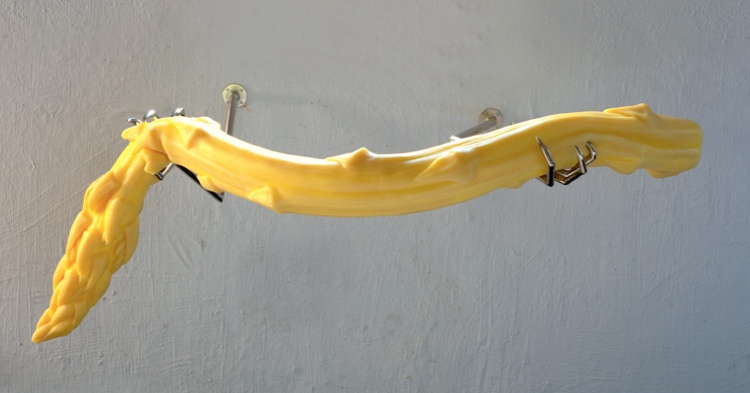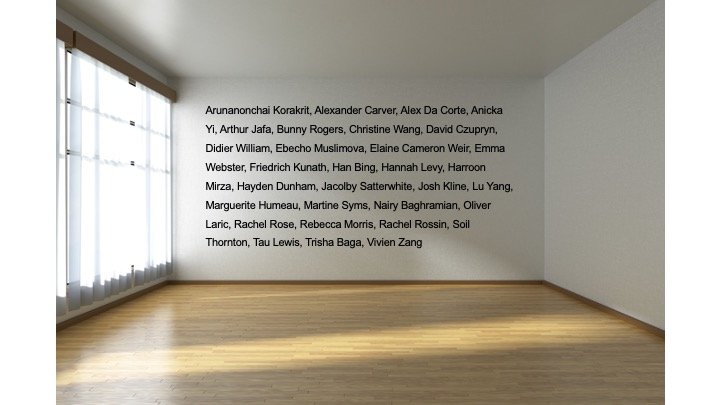










Curator’s selection from G VII collection.
London, UK, born in Cholet, France, 1986.
Two-Headed Venus, A 25-year-old pregnant female human and herself as a 90-year-old have ingested a tortoise’s brain
2018
Bronze
52 x 47 x 40 cm Edition 5/5
Humeau blends the physical and sensory experience at the crossroads between research and poetic fiction to make anthropomorphic sculptures and installations. She approaches every series of work through a phase of extensive research and collaboration with numerous specialists, academics and scientists in the field of study.
Humeau’s ambitious graduation project was an opera performed using epoxy models she created of dinosaur vocal cords, which was acquired by the Museum of Modern Art’s collection. A collaboration with a panel of specialists including paleontologists, engineers and surgeons, the research-heavy project demonstrated Humeau’s interest in collapsing science and fiction. Her interest lies in “pushing the limit of existing systems of knowledge and confronting the experts with to their own gaps in knowledge to see what happens when science stops and speculation starts.”
For Birth Canal, Humeau studied the origins of Venus figurines, prehistoric female goddess statuettes found throughout the world. Her research imagined the idea that early modern humans may have ingested animal brains for their psychoactive effects: in this theory, Venus figurines functioned as recipes, marking out an anatomical guide for shamans and those seeking spiritual ecstasy through altered consciousness.
In her installation, Humeau envisions a scene from 150,000 years ago, when Mitochondrial Eve, the most recent matrilineal ancestor common to all humans, is estimated to have lived. The digitally rendered sculptures were meticulously realized in cast bronze. Formally ambiguous, they resemble both brains and Venus figures, and represent shamanic women of different ages.
Two-Headed Venus possesses an alluring and alien-like form, that holds viewers entranced. It draws on ancient sculpture while creating parallel connections to Sherrie Levine to Constantin Brâncuș. With allusions to animism, totemism, and spiritual travel, Humeau’s installation creates a forum for these imagined voices and premonitions, underscoring the brevity of human existence relative to cosmic and geologic time.
Humeau studied the Design Academy Eindhoven and the Royal College of Art, London. Solo exhibitions include Tate Britain in 2017; Museum Haus Konstruktiv, Zurich in 2017; Schinkel Pavillon, Berlin in 2017; Les Abattoirs Musée FRAC Occitanie, Toulouse in 2017; and Palais de Tokyo, Paris in 2016. Her work has been included in Manifesta 11, Zurich in 2016.

Curator’s selection from G VII collection.
New York, USA, born in New York 1991.
Untitled
2018
Nickel plated steel, silicone, polyurethane 77 x 208 x 65 cm
Levy creates sculptures that are often at once sleek, seductive and somewhat menacing. She investigates the history of design, pairing a modernist finish-fetish with the classical victorian trope of claw-foot furniture, with talons that are reminiscent of a contemporary paired-down art nouveau style. Her objects arouse and revolt through a combination of corporeal and industrial materials. Liberating everyday forms from their usual contexts and functions, Levy makes that which is familiar, nearly to the point of invisibility, deeply strange and magnetic.
The Untitled asparagus series were originally commissioned for the windows of Bergdorf Goodman, each one uniquely cast and coloured to achieve a specific drooping and shade. The claws are individually hand-sculpted by the artist, furthering this mischievous play with the relationship between modernist design, consumption, and the body. She mixes the fleshly nature of silicone and flacid softness of materials with expertly wrought metal.
Steel claws and talons are recurring presences in her work. Those sculptures suggest chairs, sofas, or other design objects that are mysteriously coming to life, or harboring it. Bodies are always present in some form, but never in full, often skin or hints of the corporal remain.
She earned her master’s degree at the Städelschule in Frankfurt, Germany after a BFA in Cornell University. In 2018, she had solo outings at Clearing gallery in Brooklyn and Mother’s Tankstation in Dublin, Ireland, and appeared in the Maurizio Cattelan extravaganza The Artist Is Present at the Yuz Museum in Shanghai as well as This Is Not a Prop at David Zwirner in New York, among other projects. She has also been in recent group shows at MoMA PS1 in New York, Palais de Tokyo in Paris, the Louisiana Museum of Modern Art in Humlebæk, Denmark, and elsewhere.

Curator’s selection from G VII collection.
Berlin, Germany born in Isfahan, Iran, 1971.
Scruf of the Neck (Stopgap)
2016
polished aluminium rods, polished aluminium components 170 x 100 x 96 cm
Baghramian creates sculptures, photographic works, and drawings that explore relationships between architecture, everyday objects, and the human body. Her works mark boundaries, transitions, and gaps in our physical space, prompting us to consider form and meaning in the context of interior and exterior experiences. The organic forms become visible protuberances and recesses in human physiology and subjectivity.
Baghramian extrapolates the idea of the prosthesis as an emanation of a longing for physical well-being and as the ideal of “youth and health” and turns it into an abstract visual language that consists of braces, cardiac valves, membranes, and dental moulds. Baghramian’s ambition to alter art spaces into scientific examination and underline the limitations of our bodies, which modern science seeks to perfect, control and condition. Her works possess an almost surgical manner of dissecting, investigating, and meticulously creating these elements, embracing a multiplicity of references ranging from Auguste Rodin and Bruce Nauman.
Scruf of the Neck (Stopgap) was first exhibited at Déformation Professionnelle at S.M.A.K., Ghent. The solo exhibition was a new approach to the artist survey. Baghramian replaced the original invitation to do a retrospective and presented entirely new sculptures that reflect upon and alter her previous bodies of work from 1999 to 2016. The artist used the exhibition as an opportunity to take apart and make an allegory of her own pratice. Through her critical take on the artist survey, Baghramian unpacks and interrogates the conceptual, physical, and social aspects of sculpture-making today.
Scruf of the Neck (Stopgap) recalls orthodontic wirings, abject forms meant to shape your future, to mold a desired smile. She hints that history is like orthodontics: we all oblige it and give ourselves over to its will, but we really don’t know what’s going on, and it costs us so much.
Baghramian was prominently including the 58th International Art Exhibition of La Biennale di Venezia, May You Live in Interesting Times curated by Ralph Rugoff. Solo presentations took place at the Crystal Palace at the Reina Sofia Museum, Madrid; The Walker Art Center, Minneapolis in 2017, S.M.A.K, Museum of Contemporary Art, Ghent in 2016, and Museum Haus Konstruktiv, Zurich in 2016, and Punta della Dogana, Venice 2015. She has participated in Documenta 14 in 2017; and Sculpture Project Münster 17 in 2017.

Curator’s selection from G VII collection.
New York and Bangkok, born in Thailand 1986.
"Untitled (History Painting)"
2018
Denim, inkjet print on canvas, synthetic gold leaf
218.4 x 162,5 cm
Bangkok-raised artist Arunanondchai engages a myriad of subjects such as multi-generational history, authenticity, self-representation, and tourism through the lens of a cultural transplant. His work seeks to find a common ground in artistic experiences through a pastiche of styles and mediums, fusing American youth culture with Thai ancestry and zeitgeist. He often draws on family, including his twin brother and aging grandparents to showcase generational memories and cultural ties.
His evolving series of work With History in a Room Filled with Men with Funny Names feature paintings made with bleach and fire, drawing on references to Yves Klein performative Anthropométries and evoking Alberto Burri‘s poetic garment-affixed works. The works were originally shown with the video of the same title, which capture footage of modern American artists interspersed with images of Thai youth in blue jeans. In both the paintings and in the video, Arunanondchai relates the rise of denim culture with the importation and appropriation of western culture which affected everything from fashion to modern art. In the cinematic space he explores the synapses between speculation and documentary.
Arunanondchai sees denim as an American value and the indigo color representing an uncertain time. Its history is a freighted one, derived from entangled with colonialism, slave labor, and the formation of global markets. The painting attempts to make a connection between the history of Western painting and the shift in global commerce and consumption. The fire is a trompe-l'œil and mimics aspects of his performance as well as evoking a timeless spectacle.
Arunanondchai earned his BFA from the Rhode Island School of Design in 2009 and his MFA from Columbia University in 2012. The artist made his museum solo debut at the MoMA PS1, New York, in 2013 where he showed a collection of video works alongside paintings with fire and denim motifs similar to the work in the collection. He has had solo presentations with the Ullens Center for Contemporary Art, Beijing Painting, Palais de Tokyo, Paris and S.M.A.K., Ghent. Arunanondchai has been featured in major group exhibitions including the 58th International Art Exhibition of La Biennale di Venezia, May You Live in Interesting Times curated by Ralph Rugoff, the Whitney Biennial 2019 and the 9th Berlin Biennale in 2016.

Curator’s selection from G VII collection.
Born 1971, South Korea | Lives and works in New York.
15 Hissing Cockroaches
2019
Acrylic, UV Prints, LEDS, glass, resin and tubing
50 x 40 x 5 inches
In the acquired piece , Anicka Yi directs us to the dissolving boundaries between the human, animal, and vegetable and emphasizes that the question of who and what we are – what animals and bacteria and plants and machines are – is an open and urgent question. By way of her technosensual explorations of hybridization and contamination, Yi repositions the human in terms of vulnerable co-subjectivity, interdependency, and agitated symbiosis with other lively entities.
As discoveries are made in the fields of microbiome research, artificial intelligence, and animal and plant cognition, traditional ideas of individual autonomy and human exceptionalism appear wholly inadequate. Fluid entanglements between lively and intelligent entities at both the micro and macro scale reveal to us that there is no defined center, no single inner voice or single self at the helm. Neat and tidy categories no longer serve as our current models struggle to keep pace with the rapid mutations of our bodies, technologies, and environments.
Anicka Yi was born in Seoul, South Korea, and currently lives and works in New York City. Her work has been the subject of numerous solo exhibitions at institutions around the world, including the Solomon R. Guggenheim Museum, New York; Fridericianum, Kassel, Germany; Kunsthalle Basel, Switzerland; List Visual Arts Center, MIT, Cambridge, Massachusetts; The Kitchen, New York; and the Cleveland Museum of Art, Cleveland, Ohio.
Group exhibition venue highlights include the Museum of Modern Art, New York; Migros Museum fur Gegenwartskunst, Zürich, Switzerland; Walker Art Center, Minneapolis, Minnesota; Witte de With Contemporary Art, Rotterdam, The Netherlands; Fondation Louis Vuitton, Paris, France; Institute of Contemporary Art / Boston, Massachusetts; New Museum, New York; Palais De Tokyo, Paris, France;
the 2017 Whitney Biennial, New York; K11 Art Foundation, Hong Kong; the 12th Biennale de Lyon; Studiolo, Zurich; MoCA, North Miami; Museum fur Gegenwartskunst, Basel; White Flag Projects, Saint Louis; SculptureCenter, New York and White Columns, New York, amongst others.
In 2016, Yi was awarded the Hugo Boss Prize in recognition of the power and singularity of the experimental body of work she has produced over the past decade.
This May, her work will be featured in Venice at the 58th International Art Exhibition, titled May You Live In Interesting Times, curated by Ralph Rugoff, on view from May 11 until November 24, 2019.
